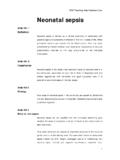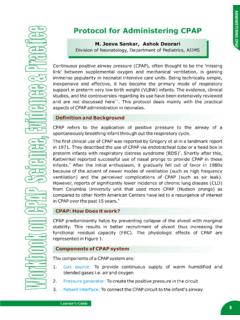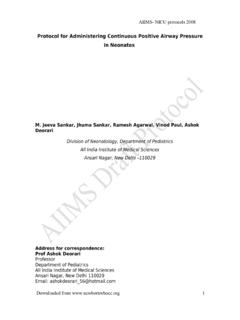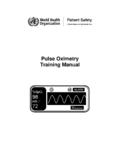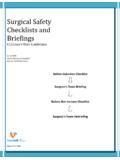Transcription of Post-resuscitation management of asphyxiated neonates
1 Post-resuscitation management of asphyxiated neonatesRajiv Aggarwal, Ashok Deorari, Vinod K Paul Division of Neonatology, Department of PediatricsAll India Institute of Medical SciencesAnsari Nagar, New Delhi 110029 Address for correspondence:Dr Vinod K PaulAdditional ProfessorDepartment of PediatricsAll India Institute of Medical SciencesAnsari Nagar, New Delhi 110029 Email: for asphyxiaPerinatal asphyxia is one of the common causes of neonatal mortality. Data from National Neonatal Perinatal database suggests that perinatal asphyxia contributes to almost 20% of neonatal deaths in India. Failure to initiate or sustain respiration after birth has been defined as criteria for the diagnosis of asphyxia by WHO.
2 Perinatal asphyxia results in hypoxic injury to various organs including kidneys, lungs and liver but the most serious effects are seen on the central nervous system. Levene s classification is a useful clinical tool for grading the severity of hypoxic ischemic encephalopathy. Good supportive care is essential in the first 48 hours after asphyxia to prevent ongoing brain injury in the penumbra region. Strict monitoring and prompt correction is needed for common problems including temperature maintenance, blood sugars, blood pressure and oxygenation. Phenobarbitone is the drug of choice for the treatment of convulsions.
3 2 Post-resuscitation management of asphyxiated neonatesAccording to latest estimates by world health organization (WHO), approximately 4 million babies die each year before they reach the age of one month1. Ninety-eight percent of these neonatal deaths take place in the developing countries. Perinatal asphyxia and birth injuries together contribute to almost 29% of these deaths1. Most of the births in developing countries occur at home, usually attended by untrained birth attendants. Failure to initiate and sustain breathing immediately after delivery has been associated with hypoxic-ischemic injury to the central nervous system (CNS) and the clinical manifestations of this injury have been termed as Hypoxic Ischemic Encephalopathy (HIE).
4 HIE is of concern in an asphyxiated neonate because it can lead to serious long-term neuro-motor sequelae among is no consensus on the definition of birth asphyxia. It is probably better to use the term perinatal asphyxia since some asphyxial events may have their origin in the perinatal period. WHO2 has defined perinatal asphyxia as a failure to initiate and sustain breathing at birth The National Neonatal Perinatal Database (NNPD), 2000 used a similar definition for perinatal asphyxia3. It defined moderate asphyxia as slow gasping breathing or an Apgar score of 4-6 at 1 minute of age. Severe asphyxia was defined as no breathing or an Apgar score of 0-3 at 1 minute of age.
5 Definitions based on Apgar scores may be useful as it can be used for formulating guidelines for post -asphyxial treatment of neonates . Apgar scores are also useful for predicting long term outcome in infants with perinatal asphyxia4,5. Indian dataAccording to NNPD 20003 data collected from 17 tertiary neonatal intensive care units in India, Apgar scores <7 at 1 minute (includes moderate and severe asphyxia) were documented in 9% of all intramural deliveries2. babies continues to have Apgar scores <7 at 5 minutes of age. Bag and mask ventilation was used in infants and less than 1% infants needed cardiac compressions and/ or medications for resuscitation at birth.
6 Perinatal asphyxia was responsible for 20% of all neonatal deaths. Manifestations of HIE were seen in approximately of all babies. Perinatal asphyxia was the commonest cause of still-births accounting for one-third of all such cases. Systemic consequences of asphyxia4 Perinatal asphyxia may result in adverse effects on all major body systems. Many of these complications are potentially fatal. In term infants with asphyxia, renal, CNS, cardiac and lung dysfunction occur in 50%, 28%, 25% and 25% cases, respectively6. The extent of organ system dysfunction determines the early outcome of an asphyxiated neonate (Table 2).
7 Hypoxic ischemic encephalopathy (HIE) refers to the CNS dysfunction associated with perinatal asphyxia. HIE is of foremost concern in an asphyxiated neonate because of its potential to cause serious long-term neuromotor sequelae among survivors. A detailed classification of HIE in term neonates was proposed by Sarnat and Sarnat7. A simple and practical classification of HIE by severity of manifestations provided by Levene is recommended for routine use (Table 2)8. Evolution of HIE changesHypoxic-ischemic brain damage is a gradually evolving process, which begins during the insult and extends beyond the resuscitation period.
8 Although the initial brain injury is related to hypoxia and ischemia, subsequent reperfusion and generation of free radicals contributes to ongoing injury. The initial hypoxic-ischemic injury results in an area of infarction. The immediate area surrounding this area is termed as penumbra. The penumbra continues to show adverse changes in the form of neuronal necrosis or apoptosis (programmed cell death) even after the hypoxic insult is over. It is possible that these post -hypoxic changes in the penumbra area may be amenable to therapeutic interventions. Good supportive therapy is essential for the first 48 hours of post -asphyxial period to reduce neuronal injury in the penumbra area.
9 The extent of penumbra and the 5duration for which these adverse changes continue is variable. This phase may also provide a therapeutic window for newer modes of therapy in asphyxiated neonates . management OF A NEONATE WITH PERINATAL ASPHYXIA Initial management (Fig. 1) management of each and every baby needs to be individualized. Given below are broad guidelines. 1. Transfer the baby to special care newborn unit. A baby who fails to initiate and sustain respiration at birth is at risk of hypoxic brain injury and needs regular monitoring. Infants with moderate asphyxia (Apgar score 4-6 at 1 minute of age) may be transferred to the mother.
10 However, these infants should also be monitored frequently in the first 48-72 hours for features suggestive of HIE. Infants with severe asphyxia (Apgar score 0-3 at 1 minute or need for prolonged bag and mask ventilation >5 minutes) should be transferred to a special care newborn unit for observation and treatment. 2. Maintain temperature Place the baby under the radiant warmer after drying the baby. Maintain normal temperature of the baby. It is during these early minutes after birth that the chances of hypothermia are highest. Hypothermia imposes additional stress to the baby by increasing metabolic needs in the face of hypoxia-ischemia.
